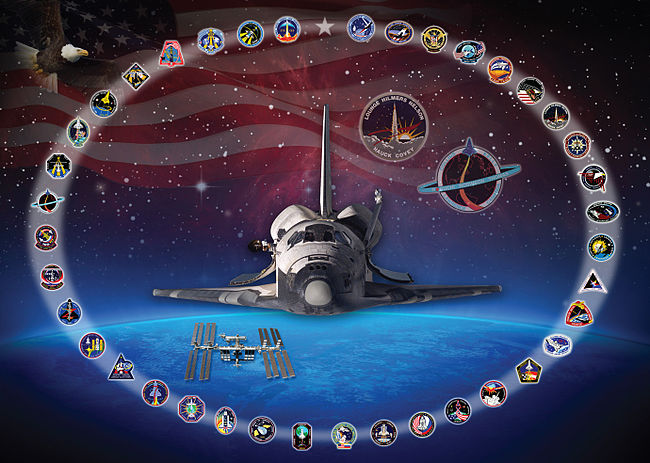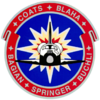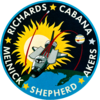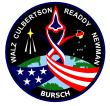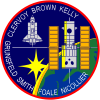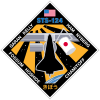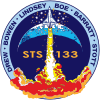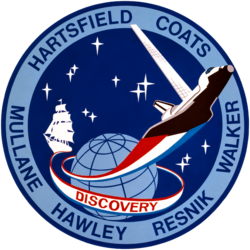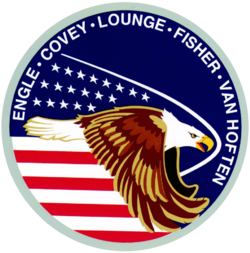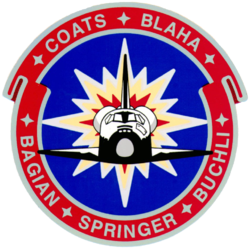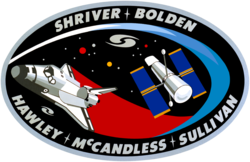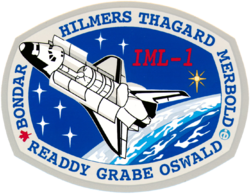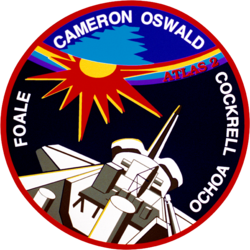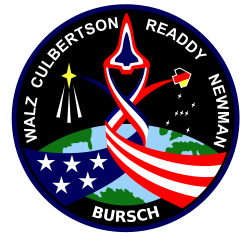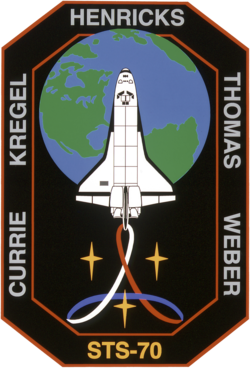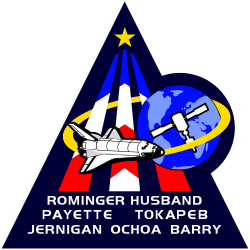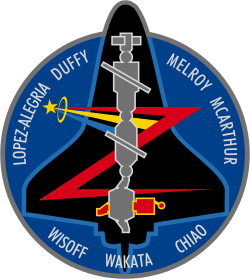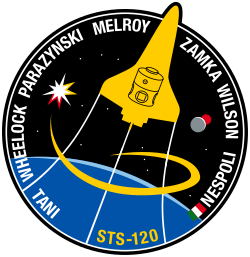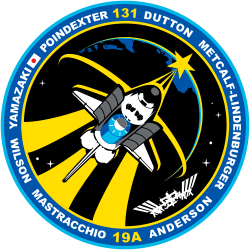Discovery (rymdfärja)
- För andra betydelser, se Discovery.
| Discovery OV-103 | |
 Discovery skjuts upp från NASAs Kennedy Space Center Launch Pad 39A på uppdraget STS-124. | |
| OV-beteckning | OV-103 |
|---|---|
| Land | USA |
| Kontraktstilldelning | 29 januari 1979 |
| Namngiven efter | Discovery (1602), HMS Discovery (1774), HMS Discovery (1874), RRS Discovery (1901) |
| Status | Pensionerad, utställd på Steven F. Udvar-Hazy Center i Chantilly, Virginia[1] |
| Första flygning | STS-41-D 30 augusti – 5 september 1984 |
| Sista flygning | STS-133 24 februari - 9 mars 2011 |
| Antal uppdrag | 39 |
| Besättningsmedlemmar | 252[2] |
| Tid i rymden | 365 dagar, 22 timmar, 39 minuter, 33 sekunder |
| Tillryggalagd sträcka | 238 539 663 km[3] |
| Satelliter utplacerade | 31 (inklusive Rymdteleskopet Hubble) |
| Mir-dockningar | 1[3] |
| ISS-dockningar | 13[3] |
Discovery (OV-103) var en amerikansk rymdfärja som gjorde sin jungfrufärd den 30 augusti 1984. Discovery var den tredje rymdfärjan som lyfte från marken, testfärjan Enterprise ej medräknad. Discovery gjorde sin sista flygning och landade på Cape Canaveral den 9 mars 2011.
Bakgrund
Namnet inspirerades av James Cooks fartyg HMS Discovery. Inofficiellt har den dock döpts efter den fiktiva rymdfarkosten Discovery One i Stanley Kubricks film 2001 – Ett rymdäventyr.
Discovery var den första rymdfärjan som lyfte efter det katastrofala uppdraget STS-51-L där Challenger totalförstördes 1986. Discoverys uppdrag fick benämningen STS-26, som även var det första uppdraget där NASA återupptog en enkel sekventiell uppdragsnumrering. Det var också Discovery som var den första rymdfärjan att lyfta efter katastrofen med Columbia 2003. STS-114, som var det officiella namnet på uppdraget, inleddes den 26 juli 2005 och avslutades den 9 augusti samma år.
1990 placerade Discovery Rymdteleskopet Hubble i sin omloppsbana under uppdraget STS-31.
På kvällen den 9 december 2006 lokal tid (EST), försenat två dagar på grund av dåligt väder, lyfte Discovery från John F. Kennedy Space Center med bland annat den svenske astronauten Christer Fuglesang ombord. Uppdraget kallas STS-116. Det var den trettiotredje uppskjutningen av Discovery vilket gjorde den till den rymdfärja som skjutits upp flest gånger.
Den svenske astronauten Christer Fuglesang gjorde även sin andra rymdfärd STS-128 ombord på Discovery. Starten planerades först till den 25 augusti 2009, för att sedan skjutas upp till den 26 augusti, och sedan återigen skjutas upp till den 28 augusti, och slutligen till lördagen den 29 augusti 2009 (svensk sommartid). STS-128/Discovery landade den 12 september klockan 02.53 svensk tid på Edwards Air Force Base i Kalifornien.
Den 38:e flygningen för Discovery STS-131 i april 2010 är färjans längsta flygning, 15 dagar 2 timmar 48 minuter 8 sekunder.
Discoverys sista resa till rymden startade den 3 februari 2011, STS-133, då hon lyfte för sista gången från Cape Canaveral i Florida på ett 11 dagar långt uppdrag. Idag är Discovery utställd vid National Air and Space Museum Steven F. Udvar-Hazy Center.
Rymdfärdsuppdragen
Referenser
Noter
- ^ ”Space Shuttle Discovery Joins the National Collection” (på engelska). 12 april 2011. Arkiverad från originalet den 21 januari 2012. https://web.archive.org/web/20120121120846/http://www.nasm.si.edu/events/pressroom/releaseDetail.cfm?releaseID=256. Läst 31 juli 2011.
- ^ ”Arkiverade kopian” (på engelska). Florida Today. 10 april 2011. Arkiverad från originalet den 16 augusti 2016. https://web.archive.org/web/20160816221633/http://www.floridatoday.com/errors/404/. Läst 25 mars 2015.
- ^ [a b c] NASA (oktober 2010). ”NASAfacts Discovery (OV-103)” (på engelska). Arkiverad från originalet den 26 oktober 2010. https://web.archive.org/web/20101026125845/http://www.nasa.gov/pdf/488540main_DISCOVERY_factsheet_10_2010.pdf. Läst 21 oktober 2010.
Externa länkar
- NASA - Discovery (OV-103)
 Wikimedia Commons har media som rör Discovery (rymdfärja).
Wikimedia Commons har media som rör Discovery (rymdfärja).
- Den här artikeln är helt eller delvis baserad på material från engelskspråkiga Wikipedia, tidigare version.
| ||||||||
| |||||||||||
| |||||||||||||||||||||||||||||||||
Media som används på denna webbplats
STS124-S-032 (31 May 2008) --- The Space Shuttle Discovery and its seven-member STS-124 crew head toward Earth-orbit and a scheduled link-up with the International Space Station (ISS). Liftoff from Kennedy Space Center's launch pad 39A occurred at 5:02 p.m. (EDT). The STS-124 mission is the 26th in the assembly of the International Space Station. It is the second of three flights launching components to complete JAXA's Kibo laboratory. During the mission, the shuttle crew will install Kibo's large Japanese Pressurized Module and its remote manipulator system. Onboard are astronauts Mark Kelly, commander; Ken Ham, pilot; Karen Nyberg, Mike Fossum, Ron Garan, Greg Chamitoff and Japan Aerospace Exploration Agency (JAXA) astronaut Akihiko Hoshide, all mission specialists. Chamitoff will join Expedition 17 in progress to serve as a flight engineer aboard the station.
This is a printable version of space shuttle Discovery's orbiter tribute, or OV-103, which hangs in Firing Room 4 of the Launch Control Center at NASA's Kennedy Space Center in Florida. Discovery's accomplishments include the first female shuttle pilot, Eileen Collins, on STS-63, John Glenn's legendary return to space on STS-95, and the celebration of the 100th shuttle mission with STS-92. In addition, Discovery supported a number of Department of Defense programs, satellite deploy and repair missions and 13 International Space Station construction and operation flights. The tribute features Discovery demonstrating the rendezvous pitch maneuver on approach to the International Space Station during STS-114. Having accumulated the most space shuttle flights, Discovery's 39 mission patches are shown circling the spacecraft. The background image was taken from the Hubble Space Telescope, which launched aboard Discovery on STS-31 and serviced by Discovery on STS-82 and STS-103. The American flag and bald eagle represent Discovery's two Return to Flight missions -- STS-26 and STS-114 -- and symbolize Discovery's role in returning American astronauts to space. Five orbiter tributes are on display in the firing room, representing Atlantis, Challenger, Columbia, Endeavour and Discovery.
STS-41D Mission Insignia
- The official mission insignia for the 41-D Space Shuttle flight features the Discovery - NASA's third orbital vehicle - as it makes its maiden voyage. The ghost ship represents the orbiter's namesakes which have figured prominently in the history of exploration. The Space Shuttle Discovery heads for new horizons to extend that proud tradition. Surnames for the crewmembers of NASA's eleventh Space Shuttle mission encircle the red, white, and blue scene.
STS-51A Mission Insignia
- The Space Shuttle Discovery en route to Earth orbit for NASA's 51-A mission is reminiscent of a soaring Eagle. The red and white trailing stripes and the blue background, along with the presence of the Eagle, generate memories of America's 208 year-old history and traditions. The two satellites orbiting the Earth backgrounded amidst a celestial scene are a universal representation of the versatility of the Space Shuttle. White lettering against the blue border lists the surnames of the five-member crew.
The crew insignia for STS Flight 51-C includes the names of its five crewmembers. The STS 51-C mission marked the third trip of the Space Shuttle Discovery into space. It was the first Space Shuttle mission totally dedicated to the Department of Defense. The U. S. Air Force Inertial Upper Stage Booster Rocket was successfully deployed. Due to the nature of the mission, few additional details of the flight were made available. Landing was made at the Kennedy Space Center, FL on January 27 at 4:23 PM EST. Mission duration was three days, one hour and 33 minutes.
Shuttle mission 51-G patch
- The STS-51G insignia illustrates the advances in aviation technology in the United States within a relatively short span of the twentieth century. The surnames of the crewmembers for the Discovery's mission appear near the center edge of the circular design.
The predominant themes are: a new beginning (sunrise), a safe mission (stylized launch and plume), the building upon the traditional strengths of NASA (the red vector which symbolizes aeronautics on the original NASA insignia), and a remembrance of their seven colleagues who died aboard Challenger (the seven-starred Big Dipper). The patch was designed by artist Stephen R. Hustvedt of Annapolis, MD.
STS-29 Mission Insignia
The STS-29 patch was designed to capture and represent the energy and dynamic nature of this nation's space program as America continues to look to the future. The folded ribbon border, the first of its kind in the Shuttle patch series, gives a sense of three dimensional depth to the emblem. The stylistic orbital maneuvering system (ONS) burn symbolizes the powerful forward momentum of the Shuttle and a continuing determination to explore the frontiers of space. The colors of the U.S. flag are represented in the patch's basic red, white, and blue background. In the border, the seven stars between the STS-29 crew names are a tribute to the crew of Challenger.
STS-33 Mission Insignia
STS-31 shuttle mission flight insignia. The mission insignia for NASA's STS-31 mission features the Hubble Space Telescope (HST) in its observing configuration against a background of the universe it will study. The cosmos includes a stylistic depiction of galaxies in recognition of the contribution made by Sir Edwin Hubble to our understanding of the nature of galaxies and the expansion of the universe. The STS-31 crew points out that is it in honor of Hubble's work that this great observatory in space bears his name. The depicted Space Shuttle trails a spectrum symbolic of both the red shift observations that were so important to Hubble's work and new information which will be obtained with the HST. Encircling the art work, designed by the crew, are the names of its members.
STS-41 Mission Insignia
STS-39 Mission Insignia
STS-48 Mission Insignia
- Designed by the astronaut crewmembers, the STS 48 patch represents the Space Shuttle Orbiter Discovery in orbit about the Earth after deploying the Upper Atmospheric Research Satellite (UARS) depicted in block letter style. The stars are those in the Northern Hemisphere as seen in the fall and winter when UARS will begin its study of Earth's atmosphere. The color bands on Earth's horizon, extending up to the UARS spacecraft, depict the study of Earth's atmosphere. The triangular shape represents the relationship among the three atmospheric processes that determine upper atmospheric structure and behavior: chemistry, dynamics and energy. In the words of the crewmembers, This continuous process brings life to our planet and makes our planet unique in the solar system."
STS-42 Mission Insignia
Emblem of Nasa's STS-53 mission
- Designed by the crewmembers, the STS-53 insignia shows the Space Shuttle Discovery rising to new achievements as it trails the symbol of the Astronaut Office against a backdrop of the American flag. The five stars and three stripes also serve to symbolize the mission designation (STS-53) and America's continuing commitment to world leadership in space. The pentagonal shape of the patch represents the Department of Defense (DOD) and its support of the Space Shuttle Program. The band delineating the flag from space includes the four colors of the military services of the crewmembers. The names of the flight crewmembers are located along the border of the patch. They are Commander David M. Walker, Pilot Robert D. Cabana, Mission Specialist (MS) Guion S. Bluford, MS James S. Voss, and MS Michael R. U. Clifford. Each crewmember contributed to the design of the insignia.
STS-56 Mission Insignia
Emblem of Nasa's STS-51 mission.
STS-60 crew patch
- The design of the crew patch for NASA's STS-60 mission depicts the Space Shuttle Discovery's on-orbit configuration. The American and Russian flags symbolize the partnership of the two countries and their crew members taking flight into space together for the first time. The open payload bay contains: the Space Habitation Module (Spacehab), a commercial space laboratory for life and material science experiments; and a Getaway Special Bridge Assembly in the aft section carrying various experiments, both deployable and attached. A scientific experiment to create and measure an ultra-vacuum environment and perform semiconductor material science – the Wake Shield Facility – is shown on the Remote Manipulator System (RMS) prior to deployment.
STS-64 Mission Insignia
STS-63 Mission Insignia
STS-70 Mission Insignia
The STS-70 crew patch depicts the Space Shuttle Discovery orbiting Earth in the vast blackness of space. The primary mission of deploying a NASA Tracking and Data Relay Satellite (TDRS) is depicted by three gold stars. They represent the triad composed of spacecraft transmitting data to Earth through the TDRS system. The stylized red, white, and blue ribbon represents the American goal of linking space exploration to the advancement of all humankind.
STS-82 Mission Insignia
- STS-82 is the second mission to service the Hubble Space Telescope (HST). The central feature of the patch is HST as the crew members will see it through Discovery's overhead windows when the orbiter approaches for rendezvous, retrieval and a subsequent series of spacewalks to perform servicing tasks. The telescope is pointing toward deep space, observing the cosmos. The spiral galaxy symbolizes one of HST's important scientific missions, to accurately determine the cosmic distance scale. To the right of the telescope is a cross-like structure known as a gravitational lens, one of the numerous fundamental discoveries made using HST Imagery. The names of the STS-82 crew members are arranged around the perimeter of the patch with the extravehicular activity's (EVA) participating crew members placed in the upper semicircle and the orbiter crew in the lower one.
The mission patch for STS-85 is designed to reflect the broad range of science and engineering payloads on the flight. The primary objectives of the mission were to measure chemical constituents in Earth's atmosphere with a free-flying satellite and to flight-test a new Japanese robotic arm designed for use on the International Space Station (ISS). STS-85 was the second flight of the satellite known as Cryogenic Infrared Spectrometers and Telescopes for the Atmosphere-Shuttle Pallet Satellite-2 CRISTA-SPAS-02. CRISTA, depicted on the right side of the patch pointing its trio of infrared telescopes at Earth's atmosphere, stands for Cryogenic Infrared Spectrometers and Telescopes for the Atmosphere. The high inclination orbit is shown as a yellow band over Earth's northern latitudes. In the Space Shuttle Discovery's open payload bay an enlarged version of the Japanese National Space Development Agency's (NASDA) Manipulator Flight Demonstration (MFD) robotic arm is shown. Also shown in the payload bay are two sets of multi-science experiments: the International Extreme Ultraviolet Hitchhiker (IEH-02) nearest the tail and the Technology Applications and Science (TAS-01) payload. Jupiter and three stars are shown to represent sources of ultraviolet energy in the universe. Comet Hale-Bopp, which was visible from Earth during the mission, is depicted at upper right. The left side of the patch symbolizes daytime operations over the Northern Hemisphere of Earth and the solar science objectives of several of the payloads.
This is the crew patch for the STS-91 mission – the ninth flight of the Shuttle-Mir Phase One docking missions. The crew will bring back Andrew S. W. Thomas, the last long-duration American crew member flown on the Russian Space Station Mir. This mission marks the end of the Shuttle-Mir Phase One Program and will open the way for Phase Two: construction of the International Space Station (ISS).
The crew patch depicts the rendezvous of the Space Shuttle Discovery with the Space Station Mir. The flags of the United States and Russia are displayed at the top of the patch and both countries are visible on the Earth behind the two spacecraft. The names of the American crew members surround the insignia on the outer areas, with the name of cosmonaut Valeriy Ryumin in Cyrillic at the lower right.
The STS-95 patch, designed by the crew, is intended to reflect the scientific, engineering, and historic elements of the mission. The Space Shuttle Discovery is shown rising over the sunlit Earth limb, representing the global benefits of the mission science and the solar science objectives of the Spartan Satellite. The bold number '7' signifies the seven members of Discovery's crew and also represents a historical link to the original seven Mercury astronauts. The STS-95 crew member John Glenn's first orbital flight is represnted by the Friendship 7 capsule. The rocket plumes symbolize the three major fields of science represented by the mission payloads: microgravity material science, medical research for humans on Earth and in space, and astronomy.
Designed by the crew members, this is the mission insignia for the STS-96 space flight, the second Space Shuttle mission dedicated to the assembly of the International Space Station (ISS). The crew patch highlights the major themes of the Station Program: Earth-directed research, the advancement of human space exploration, and international cooperation. The Space Shuttle Discovery is depicted shortly after reaching orbit as the crew prepares to carry out the first docking with the new Station. At this early stage in its construction, ISS consists of two modules: Zarya and Unity, shown orbiting Earth. The triangular shape of the patch represents building on the knowledge and experience of earlier missions, while the three vertical bars of the astronaut emblem point toward future human endeavors in space. The five-pointed star that tops the astronaut emblem in this depiction is symbolic of the five space agencies participating in the development of ISS: NASA, the Russian Space Agency, the European Space Agency, the National Space Development Agency of Japan, and the Canadian Space Agency. The blend of red, white, and blue is a tribute to the nationalities of the crew members who are from the United States, Canada, and Russia.
Designed by the crewmembers, the STS-103 emblem depicts the Space Shuttle Discovery approaching the Hubble Space Telescope (HST) prior to its capture and berthing. The purpose of the mission is to remove and replace some of the Telescope's older and out-of-date systems with newer, more reliable and more capable ones, and to make repairs to HST's exterior thermal insulation that has been damaged by more than nine years of exposure to the space environment. The horizontal and vertical lines centered on the Telescope symbolize the ability to reach and maintain a desired attitude in space, essential to the instrument's scientific operation. The preservation of this ability is one of the primary objectives of the mission. After the flight, the Telescope will resume its successful exploration of deep space and will continue to be used to study solar system objects, stars in the making, late phases of stellar evolution, galaxies and the early history of the universe. HST, as represented on this emblem was inspired by views from previous servicing missions, with its solar arrays illuminated by the Sun, providing a striking contrast with the blackness of space and the night side of Earth.
- The NASA insignia design for Shuttle flights is reserved for use by the astronauts and for other official use as the NASA Administrator may authorize. Public availability has been approved only in the form of illustrations by the various news media. When and if there is any change in this policy, which is not anticipated, it will be publicly announced.
Designed by the crew members, the STS-92 patch symbolizes the second mission to carry U.S.-built elements to the International Space Station (ISS) for assembly. The black silhouette of the Space Shuttle Discovery stands out against the deep blue background of space in low Earth orbit. In the foreground in gray is a profile view of the ISS as it appears when the shuttle and crew arrive, with the station consisting of the Unity node, its two pressurized mating adapters (PMA), the Zarya functional cargo block, the Zvezda service module, and the Progress cargo vehicle.
Following the shuttle's rendezvous and docking, the ISS configuration will be augmented by the two elements delivered by Discovery–the Z1 truss and PMA-3. These two elements, depicted in red, will be installed using the shuttle's robot arm and be connected to ISS during four spacewalks. The multi-national nature of both the STS-92 crew and the ISS are reflected in the multi-colored Astronaut Office symbol.
The STS-102 crew insignia depicts the International Space Station as it looked when Space Shuttle Discovery was docked. Visible elements include the P6 and Z1 trusses, solar arrays from the Russian segment, 2 Pressurized Mating Adapters, and the Multi Purpose Logistics Module that was temporarily attached to the underside of the Unity Node. The numbers "102" represent the mission tail number. The red, white, and blue ribbons surrounding the space station represent that this is a crew rotation flight. The colors represent the nationalities of the crewmembers (Russian and American). Underneath the ribbons are the flags of the three nations who are the major contributors to the mission (from left to right: Russia, United States, Italy). The names of the 4 permanent crewmembers are displayed in gold around the top of the emblem. Attached to the bottom are six names depicting the six rotating crewmembers (Expedition 2 on top and Expedition 1 on bottom).
The STS-105 crew patch symbolizes the exchange of the Expedition Two and Expedition Three crews aboard the International Space Station. The three gold stars near the ascending Orbiter represent the U.S. commanded Expedition Three crew as they journey into space, while the two gold stars near the descending Orbiter represent the Russian commanded Expedition Two crew and their return to Earth. The plumes of each Orbiter represent the flags of the United States and Russia and symbolize the close cooperation between the two countries. The Astronaut Office symbol, a star with three rays of light, depicts the unbroken link between Earth and the newest and brightest star on the horizon, the International Space Station (ISS). The ascending and descending Orbiters form a circle that represents both the crew rotation and the continuous presence in space aboard the ISS. The names of the four astronauts who will crew Discovery are shown along the border of the patch. The names of the Expedition Three and Expedition Two crews are shown on the chevron at the bottom of the patch. The NASA insignia design for Shuttle flights is reserved for use by the astronauts and for other official use as the NASA Administrator may authorize. Public availability has been approved only in the form of illustrations by the various news media. When and if there is any change in this policy, which we do not anticipate, it will be publicly announced.
Emblem of Nasa's STS-114 mission.
- The STS-114 patch design signifies the return of the Space Shuttle to flight and honors the memory of the STS-107 Columbia crew. The blue Shuttle rising above Earth’s horizon includes the Columba constellation of seven stars, echoing the STS-107 patch and commemorating the seven members of that mission. The crew of STS-114 will carry the memory of their friends on Columbia and the legacy of their mission back into Earth orbit. The dominant design element of the STS-114 patch is the planet Earth, which represents the unity and dedication of the many people whose efforts allow the Shuttle to safely return to flight. Against the background of the Earth at night, the blue orbit represents the International Space Station (ISS), with the EVA crewmembers named on the orbit. The red sun on the orbit signifies the contributions of the Japanese Space Agency to the mission and to the ISS program. The multi-colored Shuttle plume represents the broad spectrum of challenges for this mission, including Shuttle inspection and repair experiments, and International Space Station re-supply and repair.
The STS-121 patch depicts the Space Shuttle docked with the International Space Station (ISS) in the foreground, overlaying the astronaut symbol with three gold columns and a gold star. The ISS is shown in the configuration that it will be in during the STS-121 mission. The background shows the nighttime Earth with a dawn breaking over the horizon. STS-121, ISS mission ULF1.1, is the final Shuttle Return to Flight test mission. This utilization and logistics flight will bring a multipurpose logistics module (MPLM) to the ISS with several thousand pounds of new supplies and experiments. In addition, some new orbital replacement units (ORUs) will be delivered and stowed externally on ISS on a special pallet. These ORUs are spares for critical machinery located on the outside of the ISS. During this mission the crew will also carry out testing of Shuttle inspection and repair hardware, as well as evaluate operational techniques and concepts for conducting on-orbit inspection and repair.
The STS-116 patch design signifies the continuing assembly of the International Space Station (ISS). The primary mission objective is to deliver and install the P5 truss element. The P5 installation will be conducted during the first of three planned spacewalks, and will involve use of both the shuttle and station robotic arms. The remainder of the mission will include a major reconfiguration and activation of the ISS electrical and thermal control systems, as well as delivery of Zvezda Service Module debris panels, which will increase ISS protection from potential impacts of micro-meteorites and orbital debris. In addition, a single expedition crewmember will launch on STS-116 to remain onboard the station, replacing an expedition crewmember that will fly home with the shuttle crew. The crew patch depicts the space shuttle rising above the Earth and ISS. The United States and Swedish flags trail the orbiter, depicting the international composition of the STS-116 crew. The seven stars of the constellation Ursa Major are used to provide direction to the North Star, which is superimposed over the installation location of the P5 truss on ISS. The NASA insignia design for shuttle space flights is reserved for use by the astronauts and other official use as the NASA Administrator may authorize. Public availability has been approved only in the form of illustrations by the various news media. When and if there is any change in this policy, which is not anticipated, such will be publicly announced.
The STS-120 patch reflects the role of the mission in the future of the space program. The shuttle payload bay carries Node 2, the doorway to the future international laboratory elements on the International Space Station. On the left the star represents the International Space Station; the red colored points represent the current location of the P6 solar array, furled and awaiting relocation when the crew arrives. During the mission, the crew will move P6 to its final home at the end of the port truss. The gold points represent the P6 solar array in its new location, unfurled and producing power for science and life support. On the right, the moon and Mars can be seen representing the future of NASA. The constellation Orion rises in the background, symbolizing NASA's new exploration vehicle. Through all, the shuttle rises up and away, leading the way to the future.
Emblem of Nasa's STS-124 mission.
- The STS-124/1J patch depicts the Space Shuttle Discovery docked with the International Space Station (ISS). STS-124/1J is dedicated to delivering and installing the Japanese Experiment Module (JEM) known as Kibo (Hope) to the ISS. The significance of the mission and the Japanese contribution to the ISS is recognized by the Japanese flag depicted on the JEM Pressurized Module (JPM) and the word Kibo written in Japanese at the bottom of the patch. The view of the sun shining down upon the Earth represents the increased "hope" that the entire world will benefit from the JEM's scientific discoveries. The JPM will be the largest habitable module on the ISS and is equipped with its own airlock and robotic arm for external experiments. In addition to delivering and installing the JPM, the STS-124 crew will relocate the JEM Logistics Pressurized (JLP) module to its permanent home on the zenith side of the JPM. During three planned space walks, the crew will perform external ISS maintenance and JPM outfitting, as well as extensive robotic operations by the ISS, space shuttle, and JEM robotic arms. It will be the first time that three different robotic arms will be operated during a single space flight mission.
The shape of the STS-119/15A patch comes from the shape of a solar array viewed at an angle. The International Space Station (ISS), which is the destination of the mission, is placed accordingly in the center of the patch just below the gold astronaut symbol. The gold solar array of the ISS highlights the main cargo and task of STS-119/15A -- the installation of the S6 truss segment and deployment of S6's solar arrays, the last to be delivered to the ISS. The surnames of the crew members are denoted on the outer band of the patch. The 17 white stars on the patch represent, in the crew's words, "the enormous sacrifice the crews of Apollo 1, Challenger, and Columbia have given to our space program." The U.S. flag flowing into the space shuttle signifies the support the people of the United States have given our space program over the years, along with pride the U.S. astronauts have in representing the United States on this mission.
The STS-128 patch symbolizes the 17A mission and represents the hardware, people and partner nations that contribute to the flight. The Space Shuttle Discovery is shown in the orbit configuration with the Multi Purpose Logistics Module (MPLM) Leonardo in the payload bay. Earth and the International Space Station wrap around the Astronaut Office symbol reminding us of the continuous human presence in space. The names of the STS-128 crew members border the patch in an unfurled manner. Included in the names is the expedition crew member who will launch on STS-128 and remain on board ISS, replacing another Expedition crew member who will return home with STS-128. The banner also completes the Astronaut Office symbol and contains the U.S. and Swedish flags representing the countries of the STS-128 crew.
The STS-131/19A crew patch highlights the Space Shuttle in the Rendezvous Pitch Maneuver (RPM). This maneuver is heavily photographed by the International Space Station (ISS) astronauts, and the photos are analyzed back on earth to clear the Space Shuttle's thermal protection system for re-entry. The RPM illustrates the teamwork and safety process behind each Space Shuttle launch. In the Space Shuttle's cargo bay is the Multi-Purpose Logistics Module (MPLM), Leonardo, which is carrying several science racks, the last of the four crew quarters, and supplies for the ISS. Out of view and directly behind the MPLM, is the Ammonia Tank Assembly (ATA) that will be used to replace the current ATA. This will take place during three Extra Vehicular Activities (EVAs). The 51.6° Space Shuttle orbit is illustrated by the three gold bars of the astronaut symbol, and its elliptical wreath contains the orbit of the ISS. The star atop the astronaut symbol is the dawning sun, which is spreading its early light across the Earth. The background star field contains seven stars, one for each crewmember; they are proud to represent the United States and Japan during this mission.
The STS-133 mission patch is based upon sketches from the late artist Robert McCall; they were the final creations of his long and prodigious career. In the foreground, a solitary orbiter ascends into a dark blue sky above a roiling fiery plume. A spray of stars surrounds the orbiter and a top lit crescent forms the background behind the ascent. The mission number, STS-133, is emblazoned on the patch center, and crewmembers' names are listed on a sky-blue border around the scene. The Shuttle Discovery is depicted ascending on a plume of flame as if it is just beginning a mission. However it is just the orbiter, without boosters or an external tank, as it would be at mission's end. This is to signify Discovery's completion of its operational life and the beginning of its new role as a symbol of NASA's and the nation's proud legacy in human spaceflight.
Författare/Upphovsman: Pascal (Flickr user: pasukaru76), Licens: CC0
Vostok spacecraft replica at the Technik Museum Speyer, Germany.
